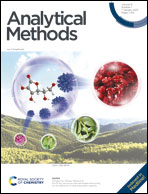Optimizing extraction solvents for deoxynivalenol analysis in maize via infrared attenuated total reflection spectroscopy and chemometric methods†
Abstract
Farmers, cereal suppliers and processors demand rapid techniques for the assessment of mould-associated contamination. Deoxynivalenol (DON) is among the most important Fusarium toxins and related to human and animal diseases besides causing significant economic losses. Routine analytical techniques for the analysis of DON are either based on chromatographic or immunoanalytical techniques, which are time-consuming and frequently rely on hazardous consumables. The present study evaluates the feasibility of infrared attenuated total reflection spectroscopy (IR-ATR) for the analysis of maize extracts via different solvents optimized for the determination of DON contamination along the regulatory requirements by the European Union (EU) for unprocessed maize (1750 μg kg−1). Reference analysis was done by liquid chromatography coupled to tandem mass spectrometry (LC-MS/MS). The studied maize samples were either naturally infected or had been artificially inoculated in the field with Fusarium graminearum, Fusarium culmorum or Fusarium verticillioides. Principal component analysis demonstrated that water and methanol–water (70 : 30% v) were optimum solvents for differentiating DON contamination levels. Supervised partial least squares discriminant analysis resulted in excellent classification accuracies of 86.7% and 90.8% for water and methanol–water extracts, respectively. The IR spectra of samples with fungal infection and high DON contamination had distinct spectral features, which could be related to carbohydrates, proteins and lipid content within the investigated extracts.



 Please wait while we load your content...
Please wait while we load your content...